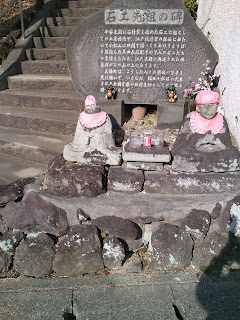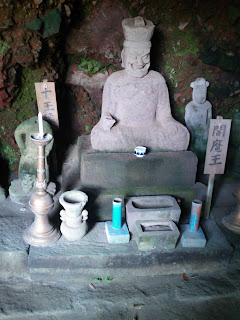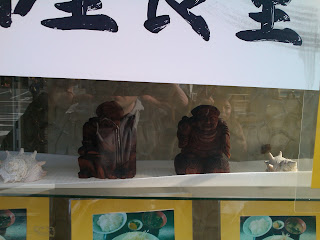In the period around New Year one can encounter a type of decoration called kadomatsu 門松 at both sides of doors or gates of private residences or shops. Nowadays the kadomatsu generally consists of three large shoots of bamboo of different lengths surrounded by pine and plum branches, but there seems to be a great variety of styles depending on the region. The pairs of kadomatsu are placed near the entrance after the 20th of December where they are supposed to beckon the toshigami 年神 (deity of the year). The toshigami will subsequently take residence in the branches according to the tradition until the branches are removed on the 6th of January. Depending on the region varies and sometimes the branches are burned to release the toshi-gami.
The three pictures shown above are taken at Yakumo-jina 八雲神社 in Kotake-chō 小竹町. Susanoo no mikoto 素盞嗚尊 has been enshrined here since the beginning of the Edo period and today he is still venerated as the uji-gami 氏神 of the residents of this area. I have visited this site several times, but now one could see pine branches here and there, attached to the tori and the o-mizuya お水舎 where visitors wash their hands and mouth before praying (or “used to wash”; there is no water left in this one). If one approaches the shrine and peeks through the wooden framework, as shown on the picture above, one can see the actual altar with traditional rice cake offerings, as shown on the picture below. These rice cakes called sonae-mochi 供え餅or kagami-mochi 鏡餅 can also be seen in houses and shops as a New Year’s decoration. They usually consist of two disks of rice cake topped by a bitter orange (or nowadays often a mandarin).

Sources:

Sources:
- Kōunsha (幸運社).『美しい日本の習慣』(Utsukushii nihon no shūkan). Tokyo: PHP Kenkyūsho (PHP研究所), 2008.
- Tōkyō jinja-chō (東京神社庁). “小竹町八雲神社” (Kotake-chō Yakumo jinja). tokyo-jinjacho.or.jp <http://www.tokyo-jinjacho.or.jp/syoukai/22_nerima/22030.html> (retrieved 2012-2-1).












